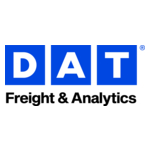DENVER–(BUSINESS WIRE)–Truckload freight volumes fell 12.8% while rising fuel surcharges pushed spot rates higher in February, said DAT Freight & Analytics, which operates the industry’s largest truckload freight marketplace and the DAT iQ data analytics service.
The prices to move dry van and refrigerated (“reefer”) freight on the spot market fell for the first time in nine months as a national average. The van rate averaged $3.10 per mile in February, a 1-cent decrease over January, while the reefer rate was $3.53 per mile, down 6 cents month over month. The flatbed rate rose a penny to $2.87 per mile.
Surcharges pushed rates higher
The national average fuel surcharge for spot van freight was 46 cents per mile in February, its highest point since September 2014 and 19 cents more than the average in February 2021.
“Spot market rates and volumes naturally decline in February as more truckload freight moves under contract,” said Ken Adamo, DAT Chief of Analytics. “Volatile diesel fuel prices have given the market a jolt, and shippers and carriers are reviewing their playbooks for ways to reduce empty miles and improve fuel efficiency.”
An “all-in” broker-to-carrier spot rate has two components: a line-haul rate and a surcharge amount that varies with the price of diesel. The average price of diesel jumped almost 75 cents to $4.85 a gallon from Feb. 27 through March 6, and the average fuel surcharge for spot van freight spiked from 45 cents to almost 60 cents per mile.
The average contract rate for van freight rose 10 cents to $3.09 per mile. It has increased for 21 consecutive months and hit $3 per mile for the first time. The average contract reefer rate was $3.25 a mile, up 9 cents, while the flatbed rate gained 8 cents to $3.43 a mile. Higher contract rates contributed to lower volumes on the spot market.
Volume declined seasonally
DAT’s Truckload Volume Index (TVI) was 227 last month, 3% lower than January. Despite a sharp decline in load-posting activity month over month, the number of loads posted to the DAT One load board network increased 24.1% compared to February 2021.
The national average van load-to-truck ratio was 7.3, down from 9.3 in January, meaning there were 7.3 available loads for every available van on the DAT network. The reefer load-to-truck ratio was 13.7, down from 20.4 in January, and the flatbed ratio edged down from 86.7 to 83.9.
How will higher fuel prices affect truckload rates?
A sudden rise in fuel prices hits freight brokers and truckload carriers in distinct ways, said Adamo.
- For brokers, a spike in fuel prices can have a deflationary effect on base or line-haul rates. “Brokers may feel compelled to suppress the line-haul rate so they can pay the fuel surcharge to the carrier and still be competitive with pricing to the shipper,” Adamo explained. “Few brokers can afford this kind of pressure for a long period of time.”
- Small carriers are especially susceptible to fuel price fluctuations because they raise costs and affect cash flow. Small carriers are less likely to negotiate bulk fuel discounts. The carrier may not get paid until 30 days or more after its invoice is delivered. By then, the cost to refill the tank may have gone up substantially.
- Fuel-saving strategies for carriers include shorter trips, not accepting dead-head miles, slowing down to improve fuel economy and even parking the truck for a while if they can’t negotiate rates that produce a comfortable margin. “Any one of these responses can affect available capacity, the distance a truck can cover in a day and ultimately the efficiency of supply chains,” Adamo said.
About the DAT Truckload Volume Index
The DAT Truckload Volume Index reflects the change in the number of loads with a pickup date during that month; the actual index number is normalized each month to accommodate any new data sources without distortion. Baseline of 100 equals the number of loads moved in January 2015, as recorded in DAT RateView, a database of rates paid on an average of 3 million loads per month.
Spot truckload rates are negotiated on a per-load basis and paid to the carrier by a freight broker. DAT rates are derived from RateView, the company’s database of $116 billion in annualized freight transactions, and include only over-the-road lanes with lengths of haul of 250 miles or more. Spot rates represent the payments made to carriers by freight brokers, third-party logistics providers and other transportation buyers. Contract rates are paid by the shipper to the carrier.
About DAT Freight & Analytics
DAT Freight & Analytics operates the largest truckload freight marketplace in North America. Shippers, transportation brokers, motor carriers, news organizations and industry analysts rely on DAT for market trends and data insights derived from 249 million freight matches and a database of $116 billion in annual market transactions. Founded in 1978, DAT is a wholly owned subsidiary of Roper Technologies (NYSE:ROP), a diversified technology company and constituent of the S&P 500, Fortune 500 and Russell 1000 indices.
Contacts
Annabel Reeves, Corporate Communications
503-501-0143; annabel.reeves@dat.com





